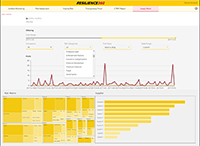DHL software tool predicts supply chain risks
"Supply Watch" product analyzes online data and social media posts with machine learning algorithms.
German transport and logistics giant Deutsche Post DHL Group has launched a software tool that can predict supply chain risks by using machine learning algorithms to analyze online data and social media posts, the company said Wednesday.
The Supply Watch product can operate as a standalone tool or as an extension of DHL's Resilience360 supply chain risk-management platform, a data-mining tool that allows users to assess hot spots in their supply chains, visualize the potential risks, and mitigate potential disruptions by adjusting factors such as production schedules, marketing budgets, or inventory positions.
Both platforms can detect disruptions in a company's supply base—such as the 2016 bankruptcy of Korean container line Hanjin Shipping Co. Ltd. or the recent global "WannaCry" ransomware attack—before they cause financial losses or long-lasting reputational damage, DHL claimed.
To detect potential supply chain disruptions, Supply Watch monitors 140 categories of risk, including financial indicators, mergers and acquisitions, environmental damages, supply shortages, quality issues, and labor disputes. The system works by using machine learning (ML) and natural language processing (NLP) technologies to analyze the data from up to 30 million posts from more than 300,000 online and social media sources, DHL said. It searches for danger signs from sources such as crime, labor breaches, quality defects, and supply chain perils such as shortages, capacity constraints, and delays.
The early alerts allow supply chain managers to "focus on early risk mitigation and auditing activities of their most relevant suppliers and third parties," Tobias Larsson, head of Resilience360, DHL Customer Solutions and Innovation, said in a release. "The insights and transparency customers gain through Supply Watch are another example of how digitalization can benefit end-to-end supply chain operations, through building resilient supply chains and enabling businesses to be more competitive."

No comments:
Post a Comment